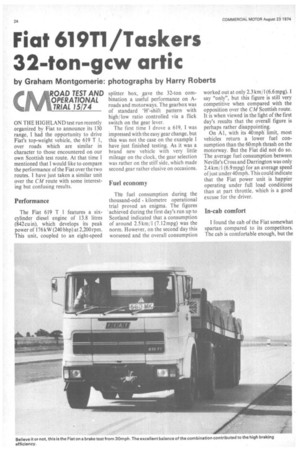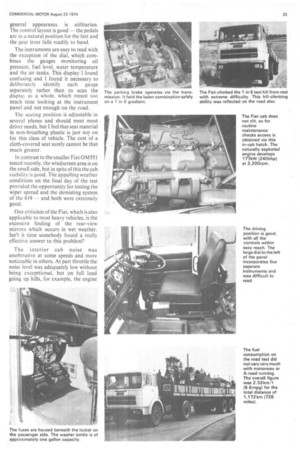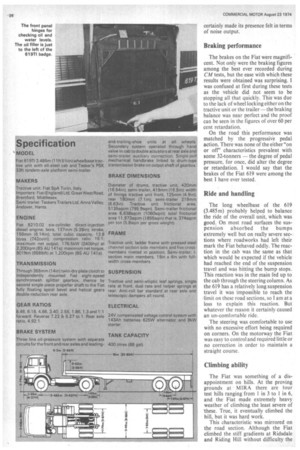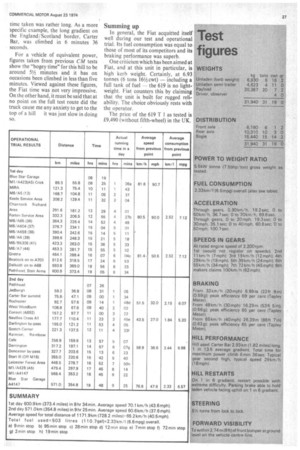Fiat 619T1/Taskers 32-ton-gcw artic
Page 28

Page 29

Page 30

Page 31

If you've noticed an error in this article please click here to report it so we can fix it.
by Graham Montgomerie: photographs by Harry Roberts
\\ZOAD TEST AND OPERATIONAL TRIAL 15174 ON THE HIGHLAND test run recently organized by Fiat to announce its 130 range, I had the opportunity to drive Fiat's top-weight vehicle, the 619 T 1, over roads which are similar in character to those encountered on our own Scottish test route. At that time I mentioned that I would like to compare the performance of the Fiat over the two routes. I have just taken a similar unit over the CM route with some interesting but confusing results.
Performance
The Fiat 619 T 1 features a sixcylinder diesel engine of 13.8 litres (842 cu in), which develops its peak power of 176 kW (240 bhp) at 2,200 rpm. This unit, coupled to an eight-speed splitter box, _gave the 32-ton combination a useful performance on Aroads and motorways. The gearbox was of standard H'-shift pattern with high, low ratio controlled via a flick switch on the gear lever.
The first time I drove a 619, I was impressed with the easy gear change, but this was not the case on the example I have just finished testing. As it was a brand new vehicle with very little mileage on the clock, the gear selection was rather on the stiff side, which made second gear rather elusive on occasions.
Fuel economy
The fuel consumption during the thousand-odd • kilometre operational trial proved an enigma. The figures achieved during the first day's run up to Scotland indicated that a consumption of around 2.5 kmi (7.12 mpg) was the norm. However, on the second day this worsened and the overall consumption worked out at only 2.3 km/1(6.6 mpg). I say "only", but this figure is still very competitive when compared with the opposition over the CM Scottish route. It is when viewed in the light of the first day's results that the overall figure is perhaps rather disappointing.
On Al, with its 40 mph limit, most vehicles return a lower fuel consumption than the 60 mph thrash on the motorway. But the Fiat did not do so. The average fuel consumption between Neville's Cross and Darrington was only 2.4 km/1 (6.9 mpg) for an average speed of j ust under 40 mph. This could indicate that the Fiat power unit is happier operating under full load conditions than at part throttle, which is a good excuse for the driver.
In-cab comfort I found the cab of the Fiat somewhat spartan compared to its competitors. The cab is comfortable enough, but the general appearance is utilitarian. The control layout is good — the pedals are in a natural position for the feet and the gear lever falls readily to hand.
The instruments are easy to read with the exception of the dial, which cornbincs the gauges monitoring oil pressure, fuel level, water temperature and the air tanks. This display I found confusing and I found it necessary to deliberately identify each gauge separately rather than to scan the display as a whole, which meant too much time looking at the instrument panel and not enough on the road.
The seating position is adjustable in several planes and should meet most driver needs, hut I feel that seat material in non-breathing plastic is just not on for this class of vehicle. The cost of a cloth-covered seat surely cannot be that much greater.
In contrast to the smaller Fiat 0 M551 tested recently, the windscreen area is on the small side, but in spite of this the cab visibility is good. The appalling weather conditions on the final day of the test provided the opportunity for testing the wiper spread and the demisting system of the 619 — and both were extremely good.
One criticism of the Fiat, which is also applicable to most heavy vehicles, is the excessive fouling of the rear-view mirrors which occurs in wet weather. Isn't it time somebody found a really effective answer to this problem?
The interior cab noise was unobtrusive at some speeds and more noticeable in others. At part throttle the noise level was adequately low without being excepttional, but on full load going up hills, for example, the engine certainly made its presence felt in terms of noise output.
Braking performance
The brakes on the Fiat were magnificent. Not only were the braking figures among the best ever recorded during CM tests, but the ease with which these results were obtained was surprising. I was confused at first during these tests as the vehicle did not seem to be stopping all that quickly. This was due to the lack of wheel locking either on the tractive unit or the trailer — the braking balance was near perfect and the proof can be seen in the figures of over 60 per cent retardation.
On the road this performance was matched by the progressive pedal action. There was none of the either "on or off' characteristics prevalent with some 32-tonners — the degree of pedal pressure, for once, did alter the degree or retardation. I would say that the brakes of the Fiat 619 were among the best I have ever tested.
Ride and handling
The long wheelbase of the 619 (3.485m) probably helped to balance the ride of the overall unit, which was good. On most road surfaces the suspension absorbed the bumps 'extremely well but on really severe sections where roadworks had left their mark the Fiat behaved oddly. The reaction in the cab was the same as that which would be expected if the vehicle had reached the end of the suspension travel and was hitting the bump stops. This reaction was in the main fed up to the cab through the steering column. As the 619 has a relatively long suspension travel it was impossible to reach the limit on these road sections, so I am at a loss to explain this reaction. But whatever the reason it certainly, caused an un-comfortable ride.
The steering was comfortable to use with no excessive effort being required on corners. On the motorway the Fiat was easy to control and required little or no correction in order to maintain a straight course.
Climbing ability
The Fiat was something of a disappointment on hills. At the proving grounds at MIRA there are four test hills ranging from I in 3 to 1 in 6, and the Fiat made extremely heavy weather of climbing the least severe of These. True, it eventually climbed the hill, but it was hard work.
This characteristic was mirrored on the road section. Although the Fiat climbed the stiff gradients at Ridsdale and Riding Hill without difficulty the time taken was rather long. As a more specific example, the long gradient on the England / Scotland border, Carter Bar, was climbed in 6 minutes 36 seconds.
For a vehicle of equivalent power, figures taken from previous CM tests show the "bogey time" for this hill to be around 51/2 minutes and it has on occasions been climbed in less than five minutes. Viewed against these figures, the Fiat time was not very impressive. On the other hand, it must be said that at no point on the full test route did the truck cause me any anxiety to get to the top of a hill it was just slow in doing so.
Summing up
In general, the Fiat acquitted itself well during our test and operational trial. Its fuel consumption was equal to those of most of its competitors and its braking performance was superb.
One criticism which has been aimed at Fiat, and at this unit in particular, is high kerb weight. Certainly, at 6.93 • tonnes (6 tons 161/2 cwt) including a full tank of fuel -the 619 is no lightweight. Fiat counters this by claiming that the unit is built for rugged reliability. The choice obviously rests with the operator.
The price of the 619 T 1 as tested is £9,490 (without fifth-wheel) in the UK.
SUMMARY
1st day 600.9km (373.4 miles) in 8hr 34min. Average speed 70.1 km/h (43.6mph).
2nd day 571.0km (354.8 miles) in 9hr 25min. Average speed 60.6km/h (37.6 mph).
Average speed for total distance of 1171.9km (728.2 miles)= 65.2 km/h (40.5 mph).
Total fuel used=503 litres (110.7gal)=2.33km/1 (6.6mpg) overall.
a) 9min stop b) 95min stop c) 28min stop d) 12min stop e) 7min stop f) 72min stop g) 2min stop h) 1,9min stop






























































































